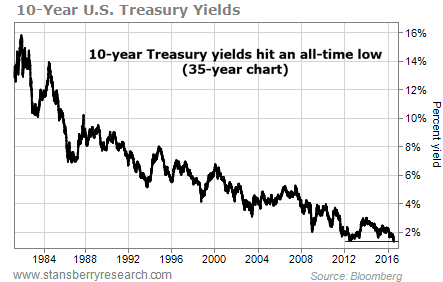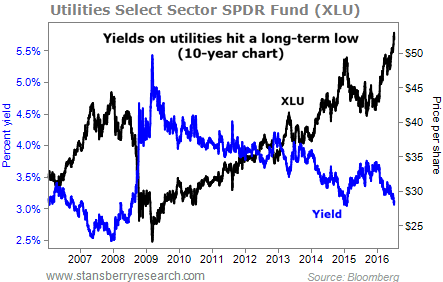If you were backed into a corner, what would you do?
You’re no longer working. Your savings won’t last the rest of your life. And your hopes of rising interest rates are being dashed over and over again.
[ad#Google Adsense 336×280-IA]Will they ever rise? Will you ever be able to earn a safe, livable income on your savings?
For people around the world, this scenario… these questions… are reality.
What would you do?
As you’ll see today, lots of folks are buying whatever they can… whatever appears to pay safe income. It’s quickly turning into a mad dash for yield.
Today, I’ll show you the evidence… and what it means for your investments.
This could be one of the most important essays you read all year.
Let’s get started…
First, let’s look at the 10-year U.S. Treasury yield. This is the world’s benchmark interest rate. If you want safe income, look to the 10-year U.S. Treasury bonds. If you want more income, you’ll have to take more risk.
That’s the idea, anyway. The investment world prices income-paying assets with that idea in mind. So when the yield on 10-year Treasurys falls, yields on other assets fall, too. And their prices rise.
The yield on 10-year U.S. Treasurys has been falling steadily for more than 30 years. And just last week, for the first time in four years, it struck a new record low. You’ll now earn less than 1.4% per year for loaning your money to the U.S. government for 10 years.

That’s abysmal. Investors need more income. And they’re looking to stocks to find it…
Income investors gravitate to certain areas of the stock market. One is consumer staples. These are the basics… things like soda, cigarettes, toothpaste, and diapers. No matter how good or bad the economy is, smokers will smoke, soda drinkers will drink soda, and most people will brush their teeth. This makes consumer-staples businesses relatively stable and able to pay regular dividends.
The top four holdings of the Consumer Staples Select Sector SPDR Fund (XLP) are Procter & Gamble (consumer goods), Coca-Cola (beverages), Philip Morris (cigarettes), and Altria (tobacco and wine). They’re all popular dividend stocks… And they’re all trading at or near decadelong highs.
Let’s look at Altria for a good example of what’s happening with these types of stocks. Shares have rocketed 287% higher over the past 10 years to an all-time high. And Altria’s dividend yield just hit an all-time low of 3.3%.

It costs more than ever to buy in to Altria’s lowest yield ever.
Utilities is another one of these areas. Utility companies provide power, water, and natural gas. Cities and states often limit utilities’ ability to raise prices. In exchange, utilities enjoy monopoly positions in their markets… and guaranteed profits.
Investors like utilities because the government-guaranteed profits turn these companies into income machines. They often pay much larger dividends than other stocks.
As with consumer-staples stocks, utilities stocks are hitting new highs… and dividend yields are near long-term lows. You can see this in the 10-year chart below of the Utilities Select Sector SPDR Fund (XLU). The fund’s yield is just shy of its eight-year low around 3%.

What does all this mean for your investments?
If you’re holding income-paying investments, it may feel like prices are getting lofty… But hold on to your positions. Prices will likely continue to rise. And the next opportunity to buy at better prices could be years away.
In my DailyWealth Trader service, we’re profiting from the trend by selling put options on great businesses that have relatively large yields. These are the stocks that income investors are buying… But by selling puts, we’re earning far greater annual yields.
As always, use stop losses. Big trends go on, and on, and on… until they don’t. When the trend turns in the other direction, the move could be dramatic.
But for now, there’s lots of uncertainty in the world. Uncertainty surrounding the U.K. leaving the European Union… uncertainty about the global economy… and even uncertainty with the U.S. economy.
The signs point toward low interest rates for the foreseeable future. The mad dash for yield is on.
Good trading,
Ben Morris
[ad#stansberry-ps]
Source: Growth Stock Wire
